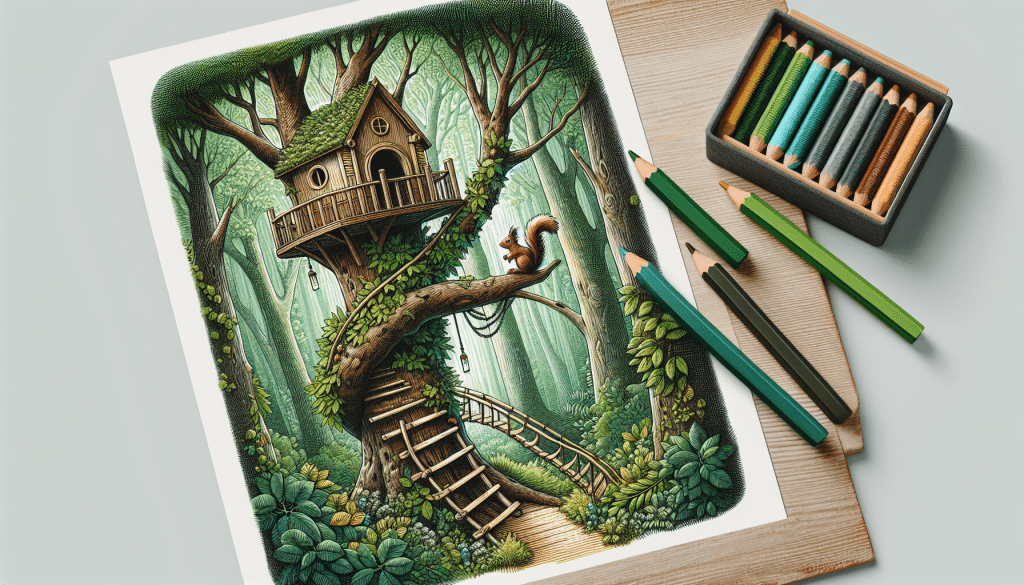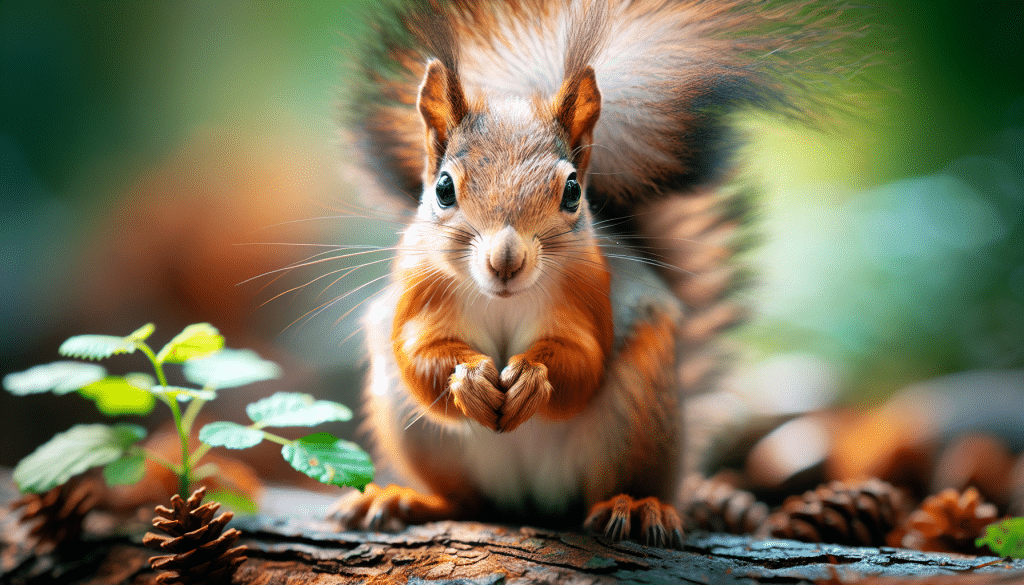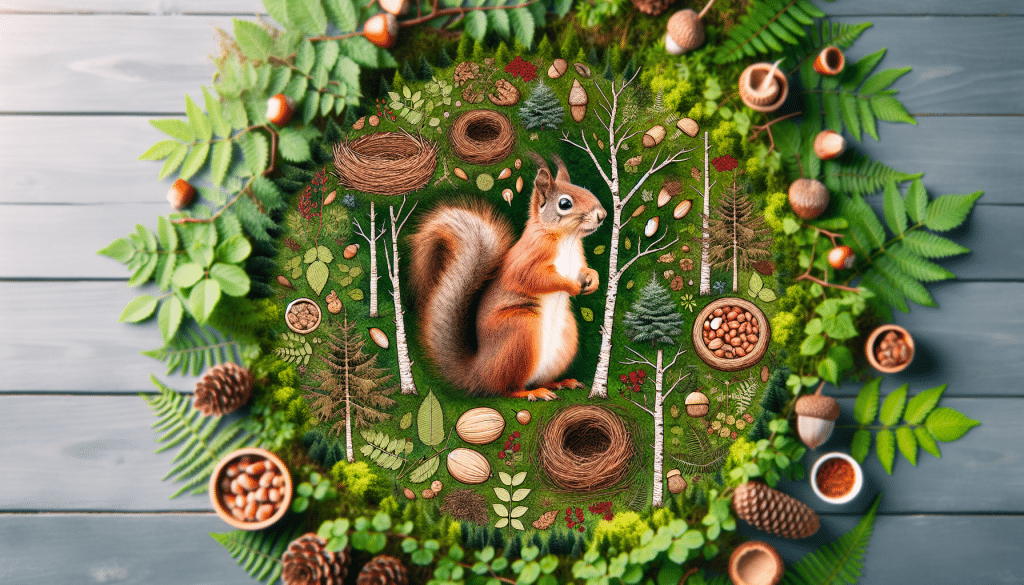Imagine if you could provide a safe and thriving sanctuary for the squirrels in your neighborhood. Picture their joy as they frolic and play, their bellies full from the abundance of food you’ve carefully placed for them. With a few simple steps and a touch of empathy, you can transform your surroundings into a haven for these delightful creatures, ensuring their well-being and fostering a harmonious coexistence. In this article, we will explore the art of creating a suitable squirrel habitat, delving into the key elements of their enrichment and sharing practical tips on how you can make a difference in their lives.

Understanding Squirrel Behavior and Requirements
Natural Behaviors of Squirrels
To create a suitable squirrel habitat, it is crucial to understand the natural behavior and requirements of these small, charismatic creatures. Squirrels are known for their arboreal lifestyle, spending the majority of their time in trees. They are agile climbers, with well-developed claws and a long, bushy tail that helps them balance. Squirrels are also known for their habit of hoarding food, burying nuts and seeds in various locations to sustain themselves during the winter months when food may be scarce. Understanding these natural behaviors is essential when designing a habitat that meets their needs.
Dietary Needs
When creating a squirrel habitat, it’s important to consider their dietary needs. As primarily herbivorous animals, squirrels have a strong preference for nuts and seeds. Acorns, hickory nuts, and pinecones are some favorites, along with various types of fruits and berries. Providing a diverse range of food sources is vital to ensure their nutritional requirements are met. Additionally, squirrels may also consume buds, bark, and fungi in their diet. Properly understanding and catering to their dietary needs is essential for the health and well-being of these energetic creatures.
Space and Territory
Space and territory play a critical role in squirrel behavior and should be considered when designing their habitat. Squirrels are territorial creatures, and each squirrel requires a designated area to call its own. The size of their territory depends on factors such as available resources, population density, and competition from other squirrels. Providing ample space within the habitat ensures that squirrels can establish and defend their territory, reducing stress and promoting overall well-being.
Safety and Predation Concerns
Creating a safe environment for squirrels is paramount to their survival. While squirrels are agile climbers, they are still vulnerable to predation and other dangers. Designing a squirrel habitat with safety in mind involves evaluating potential threats such as predators like cats, hawks, and snakes, as well as hazards like roadways or nearby construction sites. Incorporating protective measures, such as planting dense vegetation for cover or using predator guards, can help mitigate risks and ensure the safety of the resident squirrels.
Evaluating the Landscape
Types of Trees and Vegetation
When evaluating the landscape for a suitable squirrel habitat, it is crucial to assess the types of trees and vegetation present. Squirrels rely heavily on trees for shelter, food, and travel. Look for mature trees with sturdy branches that can support squirrel nests and provide ample food sources. Oak, hickory, pine, and walnut trees are particularly preferred by squirrels due to their abundance of nuts and seeds. Additionally, consider the presence of other vegetation such as fruit-bearing plants and bushes that can provide additional food sources and cover.
Availability of Water Sources
Water sources are essential for the well-being of squirrels. While squirrels obtain a significant amount of their hydration from the foods they eat, having access to fresh water is important, especially during hot and dry periods. Evaluate the landscape for natural water sources such as streams, ponds, or rivers. If these are not readily available, consider incorporating artificial watering holes, such as birdbaths or shallow dishes, within the habitat design.
Assessing Potential Dangers
Before creating a squirrel habitat, it’s important to assess any potential dangers or hazards present in the area. Identify potential sources of danger such as busy roads, aggressive predators, or human activities that may pose a threat to squirrels. By addressing and mitigating these risks, you can create a safer environment for the resident squirrels and reduce the chances of harm or injury.
Squirrel Population in the Area
Understanding the squirrel population in the area is crucial when designing a suitable habitat. Assess the density of squirrels in the local ecosystem and consider the carrying capacity of the habitat you plan to create. A habitat that can support a larger population will require more resources, such as food and nesting areas. On the other hand, a lower population may allow for a more intimate and less competitive environment. It is important to strike a balance that meets the needs of the resident squirrel population.

Trees and Plants for Squirrel Habitats
Selecting Squirrel-Friendly Trees
When selecting trees for a squirrel habitat, consider their suitability for the squirrels’ needs. Choose mature trees with dense foliage and sturdy limbs that can support nests. Look for species that produce nuts and seeds, providing a natural food source for squirrels. Examples of squirrel-friendly trees include oak, hickory, walnut, pine, and maple.
Nut and Fruit-Bearing Plants
In addition to trees, incorporating nut and fruit-bearing plants within the habitat enhances the availability of food sources. Plant species such as hazelnut bushes, blackberry vines, and wild strawberry patches can provide fresh produce for the squirrels, contributing to a diverse and nutritious diet.
Shelter Providing Bushes and Shrubs
Including shelter-providing bushes and shrubs in the habitat design ensures that squirrels have places to hide, seek protection, and establish their nests. Consider planting dense shrubs like elderberry, viburnum, or serviceberry. These not only offer cover but can also offer additional food sources.
Toxic Plants to Avoid
While selecting plants for a squirrel habitat, it is important to identify and avoid toxic plants that could cause harm. Some common garden and household plants, such as daffodils, rhododendrons, or lilies, can be toxic to squirrels if ingested. Do thorough research on the plants you plan to include and ensure they are safe for the resident squirrel population.
Designing and Building Nesting Areas
Nesting Box Design
Nesting boxes are a valuable addition to a squirrel habitat, providing safe and secure spaces for squirrels to raise their young. When designing nesting boxes, ensure they are made of durable materials such as wood and have appropriate dimensions to accommodate squirrels comfortably. Provide an entrance hole of suitable size for the squirrel species in your area and include a removable lid for easy cleaning and maintenance.
Placement of Nesting Boxes
Strategic placement of nesting boxes is essential to encourage squirrel occupancy. Place the boxes high above the ground, at a height of at least 12 feet, to provide security from predators. Consider positioning the boxes in close proximity to food and water sources, and ensure they receive adequate sunlight for warmth.
Maintaining and Monitoring Nests
Once the nesting boxes are in place, it is important to regularly maintain and monitor them. Inspect the boxes for any damage, remove any debris or parasites, and clean them periodically. Regular maintenance helps ensure the nests remain safe and comfortable for the resident squirrels.
Incorporating Natural Nesting Options
While nesting boxes are beneficial, it is equally important to provide natural nesting options within the habitat. Encourage the growth of mature trees with hollows or cavities, as these can serve as natural nesting sites for squirrels. Fallen logs and dense vegetation also create opportunities for nests. Incorporating these natural options gives squirrels a choice and mimics their natural habitat.

Providing a Healthy Diet
Setting up Feeding Stations
To supplement their diet and further enhance the habitat, providing feeding stations can be beneficial. These stations should be designed to keep the food dry and protect it from other wildlife. Place the feeding stations away from busy areas to reduce disturbance and ensure the squirrels have easy access to their food.
Choosing the Right Foods
Offering a balanced diet is crucial when setting up feeding stations. Provide a variety of nuts, seeds, and fruits, both in their whole form and as a mix. Foods like sunflower seeds, peanuts, corn, and apples are commonly enjoyed by squirrels. Avoid feeding them processed or sugary foods that can be harmful to their health.
Timing and Quantity of Feedings
Establish a feeding schedule that aligns with the squirrels’ natural feeding patterns. Aim for consistency so that the squirrels can rely on the availability of food. Avoid overfeeding, as this can lead to dependency and health issues. Offer small quantities of food at regular intervals to support their natural foraging behavior.
Preventing Dependency on Human-provided Food
While supplemental feeding can be beneficial, it is important to prevent squirrels from becoming overly reliant on human-provided food. Supplemental feeding should be viewed as an extra resource rather than the main source of sustenance. By maintaining a balance between natural foraging and supplemental feeding, squirrels will retain their ability to find their own food in the wild.
Water Sources for Hydration and Bathing
Creating Natural Watering Holes
Providing natural watering holes within the squirrel habitat is essential for their hydration needs. These can include small ponds, shallow depressions filled with water, or even naturally occurring sources like streams. Incorporating such water features not only allows squirrels to quench their thirst but also provides opportunities for bathing, which helps maintain their coat’s cleanliness and health.
Safe Placement of Water Containers
In instances where natural water sources are not readily available, placing water containers strategically can ensure squirrels have access to clean water. Choose shallow containers that allow squirrels to drink without the fear of drowning. Place them in quiet and secluded areas of the habitat away from potential dangers.
Maintaining Cleanliness
Regularly clean and refill the water sources to maintain cleanliness and prevent the growth of harmful bacteria. Provide fresh water daily, especially during hot and dry weather when squirrels are likely to be more reliant on external water sources.
Protecting Water Sources from Freezing
During winter months, it is essential to take measures to prevent water sources from freezing. Utilize insulated water containers or consider installing a heating element to keep the water at a drinkable temperature. Providing access to unfrozen water is crucial for the squirrels’ well-being during colder periods.
Creating Safe Havens from Predators
Strategic Planting for Cover
Creating safe havens from predators involves strategic planting of vegetation that provides cover and protection for squirrels. Dense shrubbery, thorny bushes, or ascending vines can deter predators like cats and offer squirrels secure pathways within the habitat. Planting in layers to create varying heights and dense patches of vegetation can help create safe spaces for the squirrels.
Use of Predator Guards
Incorporating predator guards, such as baffles or collars, around trees or feeding stations can prevent predators from climbing and accessing the squirrels. These barriers should be positioned at a height that is too high for predators to jump or reach, effectively adding an extra layer of protection.
Human Intervention Strategies
In situations where squirrels face immediate danger, human intervention may be necessary. This can include safely relocating injured squirrels to wildlife rehabilitation centers or intervening when squirrel nests are threatened by construction activities. It is crucial to work with local wildlife authorities or experts to ensure the safety and well-being of the squirrels during such interventions.
Educating Neighbors and Community
Raising awareness and educating neighbors and the community about the importance of squirrel habitats and the potential risks they face can aid in creating a safe environment for these creatures. Encourage practices that minimize harm to squirrels, such as keeping domestic cats indoors or using pet-safe bird feeders. Promote responsible pet ownership and provide information on local wildlife conservation efforts.
Squirrel Enrichment for Well-Being
Interactive Food Puzzles
Enriching a squirrel habitat involves providing mental and physical stimulation to keep the squirrels engaged and entertained. Interactive food puzzles can be a great addition to their environment. These puzzles require problem-solving skills, allowing squirrels to use their natural foraging abilities to obtain rewards, such as hidden nuts or seeds.
Climbing Structures and Play Areas
Squirrels are natural climbers and providing structures such as wooden platforms, climbing poles, or trees with branches at varying heights can encourage their natural instincts and physical activity. These structures not only enhance the habitat but also give squirrels opportunities for play and exercise.
Mimicking Natural Foraging
Creating opportunities for natural foraging within the habitat is essential for squirrel enrichment. Scatter food items throughout the habitat, simulating the experience of finding and harvesting food in the wild. This allows squirrels to utilize their natural instincts for searching and gathering, providing mental stimulation and reinforcing their natural behaviors.
Seasonal Enrichment Activities
Varying the habitat’s features and activities throughout the seasons can further enrich the lives of squirrels. For example, during the winter months, incorporate warm nesting materials or additional food sources to help squirrels cope with the cold. In the spring, include flowering plants that can attract pollinators, providing additional food sources for the squirrels.
The Role of Supplemental Feeding
Supplemental Food Types
Supplemental feeding can play a role in supporting squirrel populations, especially during periods of food scarcity. In addition to nuts and seeds, provide supplemental foods like vegetables, cooked grains, or protein-rich items such as eggs or mealworms. It is crucial to offer a diverse range of foods to ensure proper nutrition.
Balancing Natural and Supplemental Feeding
When providing supplemental food, it is vital to strike a balance between natural foraging and supplementation. Supplemental feeding should not replace the squirrels’ inherent ability to find their own food. Use supplemental feeding as a temporary measure during times when natural food sources are scarce.
Monitoring Health and Population
Regular monitoring of the squirrel population and their health is important when providing supplemental feeding. Keep track of the number of squirrels frequenting the feeding stations and observe their physical condition. Recognize any signs of disease or distress and seek professional assistance if needed.
Local Regulations on Wildlife Feeding
Before initiating any supplemental feeding programs, it is crucial to understand and comply with local regulations. Some areas may have specific guidelines or restrictions on wildlife feeding, particularly in urban or densely populated regions. Knowing and adhering to these regulations ensures the well-being of both the squirrels and the surrounding ecosystem.
The Impact of Climate Change on Squirrel Habitats
Understanding the Effects of Weather Patterns
Climate change has significant impacts on squirrel habitats, altering weather patterns that influence food availability and hibernation behaviors. Increasing temperatures, changes in precipitation, and alterations in vegetation cycles can all affect the ecological balance. Understanding the specific impacts of climate change in your region allows for better preparedness and adaptation.
Mitigating the Impact of Climate Change
To mitigate the impact of climate change on squirrel habitats, it is crucial to focus on overall ecological conservation efforts. This includes reducing greenhouse gas emissions, conserving natural areas, and restoring damaged ecosystems. By contributing to larger conservation initiatives, you can help safeguard squirrel habitats and ensure their long-term survival.
Adaptive Strategies for Habitat Enhancement
To address the challenges posed by climate change, consider implementing adaptive strategies within squirrel habitats. This can involve planting climate-resilient vegetation, providing artificial structures for nesting and shelter, and maintaining diverse and sustainable food sources. Creating a habitat that can withstand and adapt to changing climate conditions is crucial for the survival of squirrel populations.
Contributing to Larger Ecological Conservation Efforts
While enhancing squirrel habitats is important, it is equally essential to contribute to larger ecological conservation efforts. Support local conservation organizations, participate in reforestation initiatives, and engage in community education and outreach programs. By working together, we can make a positive impact on squirrel habitats and contribute to the conservation of the entire ecosystem.
In conclusion, creating a suitable squirrel habitat involves understanding their natural behaviors and dietary needs, evaluating the landscape for appropriate trees and vegetation, designing and building nesting areas, providing a healthy diet and water sources, creating safe havens from predators, offering enrichment activities, considering supplemental feeding, and addressing the impact of climate change. By following these guidelines, you can create a welcoming and sustainable environment for squirrels while also contributing to their overall well-being and conservation. Remember, empathy and thoughtful consideration are key when designing and maintaining squirrel habitats.


